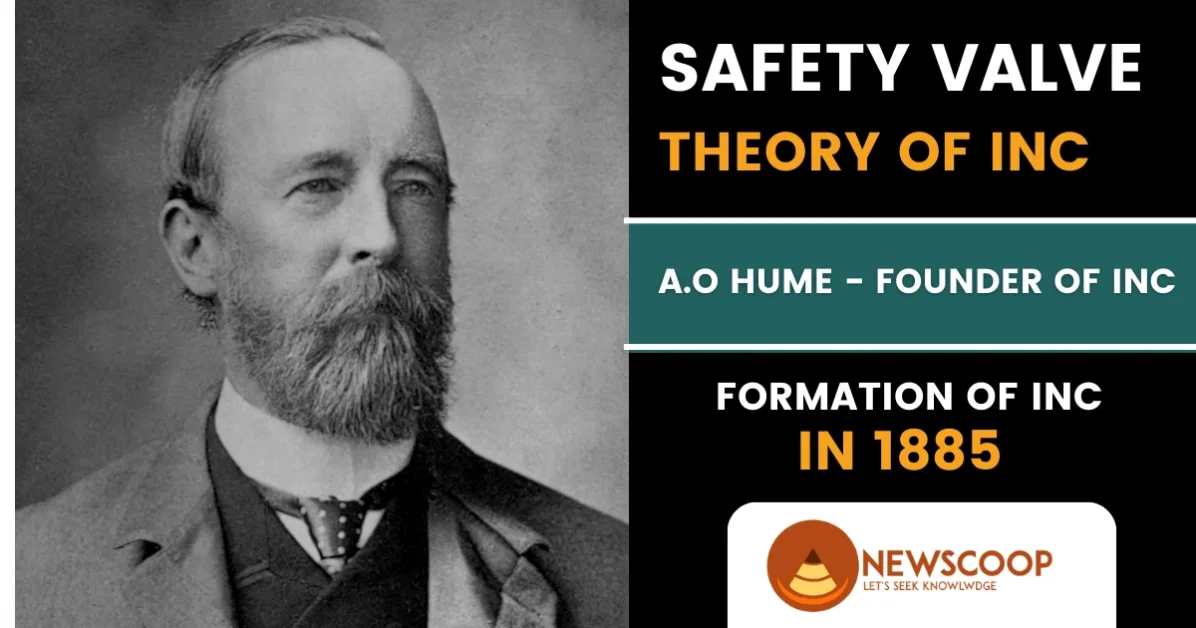The Safety Valve Theory has been a topic of discussion in political science, implying a mechanism through which citizens can express their displeasure and discontent against legislation and government policies.
However, in this article, we will explore whether the Safety Valve theory truly applies to the formation of the Indian National Congress. Let’s see if this theory applies to how the Indian National Congress came into being.
| Theory | Safety Valve Theory |
| Given by | A.O. Hume |
| Purpose | Pressure Release |
| Supporters | Rai, Dutt, Golwalkar, Andrews |
| Evidence | Controversial |
| Outcome | INC Formation |
What is the Safety Valve Theory?
The Safety Valve theory suggests that people should have the freedom to speak up peacefully against government policies when they’re unhappy. It’s like a safety valve that helps release pressure when people feel dissatisfied.
Origin of Safety Valve Theory
According to the prevailing myth, the Indian National Congress(INC) was established in 1885 by A.O. Hume, who purportedly received guidance from Lord Dufferin, the then Viceroy of India. Lord Dufferin, the narrative goes, envisioned Congress as a safety valve—a platform where people could express their grievances and dissent peacefully, avoiding the escalation of revolutionary movements similar to the Revolt of 1857.
This theory has persisted through generations, shaping how scholars, analysts, and students perceive Congress’s role in India’s struggle for independence.
Interpreting the Safety Valve Theory
Over time, various groups have interpreted the Safety Valve Theory in ways that align with their ideologies:
- Liberals: Embrace the theory as it highlights the importance of a peaceful outlet for grievances, potentially avoiding bloodshed.
- Radicals: Criticize Congress, contending that it compromised with imperialism instead of seeking radical changes.
- Extreme Right Wing: Use the theory to label Congress as an anti-national organization, undermining its role in India’s freedom struggle.
- Leftists: Argue that Congress was formed to safeguard capitalist and British interests, thereby limiting its impact on genuine revolution.
Who Believes this Theory?
Several individuals and historians have supported the Safety Valve theory over time:
- Lala Lajpat Rai: In 1916, he used the Safety Valve theory to attack the moderates in Congress, suggesting that it was started by Lord Dufferin to save the British empire rather than to win political liberties for India.
- R. Palme Dutt: In his work ‘India Today,’ he argued that Congress was created as a secret plan with the Viceroy to safeguard the British empire against rising discontent and anti-British sentiment, acting as a vehicle for opposition rather than real change.
- M.S. Golwalkar: The then RSS chief used the theory to criticize Congress for its secularism and labeled it as anti-national. He advocated a triangular fight between Hindus, Muslims, and the British.
- Liberals like C.F. Andrews and Girija Mukherjee: Fully accepted the Safety Valve theory, suggesting that Congress served as a safety valve to prevent unnecessary violence.
Is there any Evidence?
The existence of secret reports attributed to A.O. Hume, detailing simmering discontent in India, has been a subject of debate among historians. Despite claims made by some scholars, no concrete evidence of these reports has been found when researchers sought them in historical archives.
The absence of such evidence raises doubts about the veracity of this aspect of the Safety Valve Theory. As historians continue their quest for truth, the question of these mysterious reports remains unanswered, leaving the theory’s credibility open to interpretation.
Also Read: Drain of Wealth Theory

Conclusion
In conclusion, the Safety Valve Theory remains a subject of contention and debate among historians and scholars alike. While it may have influenced some aspects of the Indian National Congress’s formation, its significance in shaping the course of India’s freedom struggle remains uncertain.
As we continue to explore historical narratives, let us remain open to new evidence and interpretations that may shed further light on this intriguing chapter of Indian history.
Thank You!
FAQs
What is the Safety Valve theory?
In political science, the Safety Valve theory suggests that citizens should have the freedom to speak up against government policies without resorting to violence. It acts like a safety valve that releases pressure when people are dissatisfied.
Did the Safety Valve Theory Apply to the Indian National Congress?
Some people believe that the Indian National Congress was created as a safety valve to prevent a violent revolution against British rule.
Who gave the Safety Valve Theory?
The Safety Valve Theory was given by A.O. Hume under Lord Dufferin’s guidance to prevent violent revolution. This led to the formation of the Indian National Congress,





